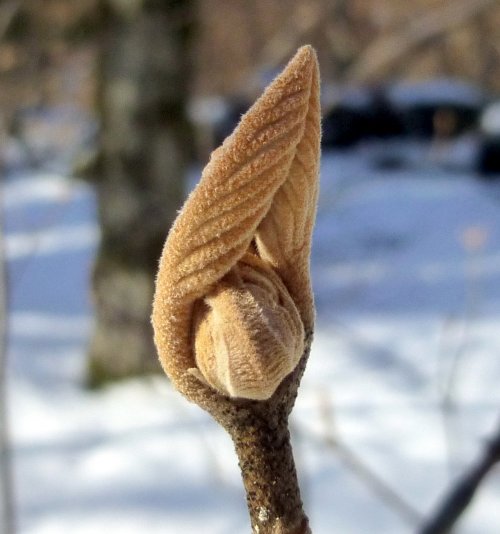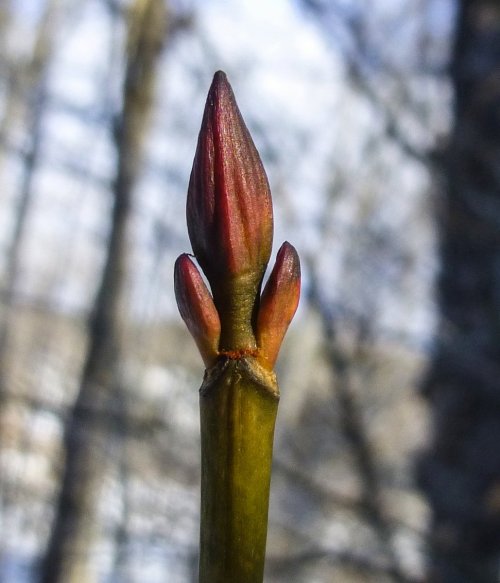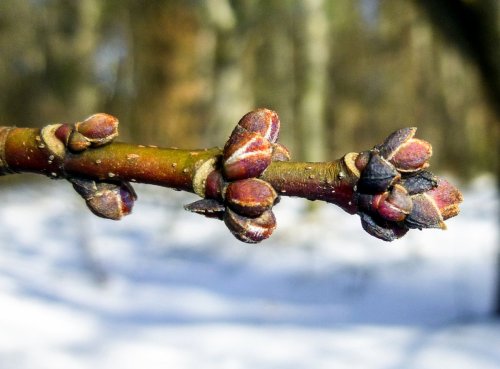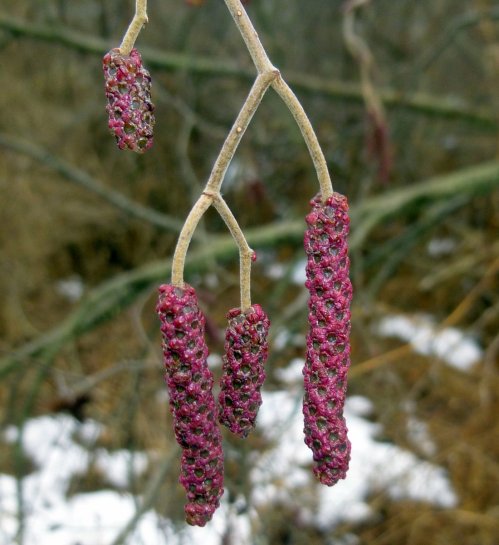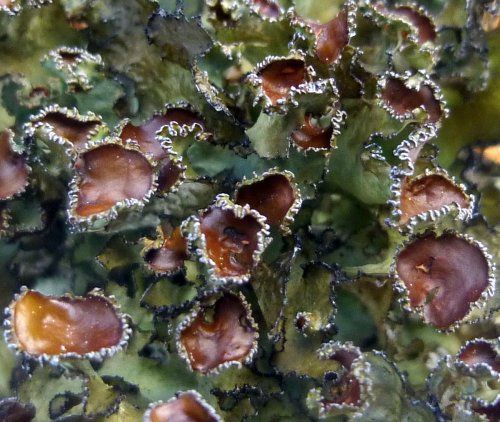I like the reds and orangey browns and the velvety texture of hazelnut husks. They add a nice touch of color to the gray and white world of winter. The nuts are a favorite of many birds and animals including turkeys and squirrels so they disappear quickly. This photo is of American Hazelnut (Corylus americana) but we also have beaked hazelnut (Corylus cornuta) in parts of the state.
This is the time of year that I start watching buds to see what they’re up to. Hobblebush (Viburnum alnifolium) flower and leaf buds are naked, meaning they have no bud scales. Though there might be plenty of snow the ground is frozen, so none of the moisture is available to plants and bud scales help conserve moisture. Plants that have no bud scales have evolved other ways to protect their buds, and one of those ways is by wearing wooly winter coats like the hobblebush does.
Nannyberry (Viburnum lentago) buds always remind me of long beaked birds. This is another native viburnum but instead of being naked its terminal flower buds have two scales. They’re a good example of valvate bud scales, which simply means the margins of the two bud scales touch but don’t overlap. This shrub is easily confused with wild raisin (Viburnum cassinoides) in the winter because its flower buds are very similar, but the bud scales on wild raisin tend to split open more around the swollen part of the bud.
Striped maples (Acer pensylvanicum) have colorful twigs and buds and are among the easiest trees to identify no matter what time of year because of the green and white vertical stripes on their bark. Their terminal buds have two scales and are valvate like the nannyberry buds.
Red maples (Acer rubrum) protect their buds with as many as four pairs of rounded, hairy edged bud scales. The scales are often plum purple and the bud inside tomato red. This is one of the first of our native trees to blossom in spring and also one of the most beautiful, in my opinion. Each small bud holds as many as 6-8 red blossoms. Red maple trees can be strictly male or female, or can have both male and female blossoms on a single tree. They bloom before the leaves appear and large groves of them can wash the landscape with a brilliant red haze which shouts that spring has arrived.
This is also the time of year that I start to watch catkins for signs of pollen production. Before too long alder catkins will open their purple scales and burst with golden pollen, and the edges of ponds and streams will be draped with their dangling beauty for a short time.
Black birch (Betula lenta) catkins will do the same, but they aren’t quite as showy as alder catkins. Black birch twigs taste like wintergreen when they’re chewed so that’s how I make sure I have the correct tree. Black birch was once harvested, shredded and distilled to make oil of wintergreen, and so many were taken that they can be very hard to find now. I know where a few grow but they aren’t a common sight. Young trees are easy to confuse with cherry.
Speaking of cherry, one day I saw several young trees with black knot disease. It is caused by the fungus Apiosporina morbosa which can also attack plums, peaches, and apricots. Spores from the fungus can be spread by rain or wind and typically infect trees from April through June on new growth. Infected stems swell up and produce hard black knots like those in the above photo. This disease can eventually kill the tree so infected limbs should be pruned off 2-4 inches below the knots and buried or burned before bud break the following spring.
A gall wasp called Callirhytis quercussimilis caused this swelling on the trunk of this scrub oak (Quercus ilicifolia.) If the trunk had twisted just a bit differently it would have made a great cane.
The dried, open cones of northern white cedar (Thuja occidentalis) look like tiny, carved wooden flowers. Gone are the eight seeds that each one holds, but the flattened, scale-like leaves so common on cedars can be seen in this photo. Native Americans showed 16th century French explorer Jacques Cartier how to cure scurvy with the leaves of this tree and he was so impressed that he named it Arborvitae, which is Latin for Tree of Life. He also had trees with him when he returned to Europe, and Thuja occidentalis became the first North American tree to be introduced there.
Indian pipe (Monotropa uniflora) seed pods also look like tiny carved wooden flowers. Most have split open by now to release tens of thousands of seeds to the wind, but not this one. It has cracked open though and since the individual seeds are only ten cells thick, some have probably escaped.
Fallen branches are great places to find lichens and fungi in the winter so I always take a closer look at them. This one had a large area of what I think was white rot fungus (Phanerochaete chrysorhizon) growing on it. This toothed crust fungus is a deep, orangey- brown and has folds that look like teeth. It is very similar to the milk white, toothed polypore (Irpex lacteus) but that fungus has edges that curl.
I found this leafy (foliose) rimmed camouflage lichen (Melanelia hepatizon) growing on a white pine branch but it can grow on stone and is also called rock leather. Its body (thallus) is very dark olive green with brown and black here and there. Its fruiting bodies (apothecia) are rosy brown disk like structures with white ruffled edges that look as if they’d been dipped in powdered sugar. These white bits are called Pseudocyphellae, which are pores in the body of the lichen that open to the medulla. The medulla is a layer made up of long, thread like structures called hyphae which in turn make up the fungal part of the lichen. If we revisit lichens 101 we remember that lichens are actually composite organisms that emerge from algae or cyanobacteria (or both) living among filaments of a fungus in a mutually beneficial (symbiotic) relationship. Phew. Some lichens can be almost as difficult to describe as they are to identify.
Though I enjoy finding things in nature that I’ve never seen before and love to learn all about them, sometimes I like to put away the books, forget all the big words and just enjoy the staggering beauty of it all. The unfurled bark of this tree limb showed its striking and unexpected colors that were hidden within, and it reminded me of how lucky I am to be able to see such things, and how very grateful I should be for the opportunity. After a whispered thank you for all of the wonderful things I had seen on this day I headed for home with a glad heart.
What right do I have to be in the woods, if the woods are not in me? ~John Cage
Thanks for coming by.

